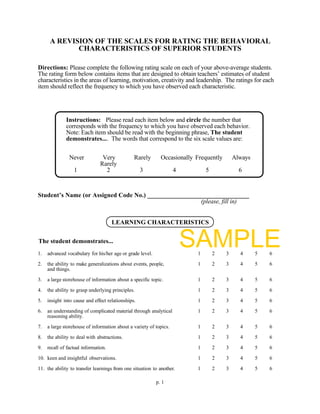
SRBCSS Scale
- 1. A REVISION OF THE SCALES FOR RATING THE BEHAVIORAL CHARACTERISTICS OF SUPERIOR STUDENTS Directions: Please complete the following rating scale on each of your above-average students. The rating form below contains items that are designed to obtain teachers’ estimates of student characteristics in the areas of learning, motivation, creativity and leadership. The ratings for each item should reflect the frequency to which you have observed each characteristic. Instructions: Please read each item below and circle the number that corresponds with the frequency to which you have observed each behavior. Note: Each item should be read with the beginning phrase, The student demonstrates.... The words that correspond to the six scale values are: Never Very Rarely Occasionally Frequently Always Rarely 1 2 3 4 5 6 Student’s Name (or Assigned Code No.) ________________________________ (please, fill in) LEARNING CHARACTERISTICS The student demonstrates... 1. advanced vocabulary for his/her age or grade level. SAMPLE 1 2 3 4 5 6 2. the ability to make generalizations about events, people, 1 2 3 4 5 6 and things. 3. a large storehouse of information about a specific topic. 1 2 3 4 5 6 4. the ability to grasp underlying principles. 1 2 3 4 5 6 5. insight into cause and effect relationships. 1 2 3 4 5 6 6. an understanding of complicated material through analytical 1 2 3 4 5 6 reasoning ability. 7. a large storehouse of information about a variety of topics. 1 2 3 4 5 6 8. the ability to deal with abstractions. 1 2 3 4 5 6 9. recall of factual information. 1 2 3 4 5 6 10. keen and insightful observations. 1 2 3 4 5 6 11. the ability to transfer learnings from one situation to another. 1 2 3 4 5 6 p. 1
- 2. Never Very Rarely Occasionally Frequently Always Rarely 1 2 3 4 5 6 CREATIVITY CHARACTERISTICS The student demonstrates... 12. imaginative thinking ability. SAMPLE 1 2 3 4 5 6 13. a sense of humor. 1 2 3 4 5 6 14. the ability to come up with unusual, unique, or clever responses. 1 2 3 4 5 6 15. an adventurous spirit or a willingness to take risks. 1 2 3 4 5 6 16. the ability to generate a large number of ideas or solutions to 1 2 3 4 5 6 problems or questions. 17. a tendency to see humor in situations that may not appear to be 1 2 3 4 5 6 humorous to others. 18. the ability to adapt, improve, or modify objects or ideas. 1 2 3 4 5 6 19. intellectual playfulness, willingness to fantasize, and 1 2 3 4 5 6 manipulate ideas. 20. a non-conforming attitude, does not fear being different. 1 2 3 4 5 6 MOTIVATION CHARACTERISTICS The student demonstrates... 21. the ability to concentrate intently on a topic for a long period SAMPLE 1 2 3 4 5 6 of time. 22. behavior that requires little direction from teachers. 1 2 3 4 5 6 23. sustained interest in certain topics or problems. 1 2 3 4 5 6 24. tenacity for finding out information on topics of interest. 1 2 3 4 5 6 25. persistent work on tasks even when setbacks occur. 1 2 3 4 5 6 26. a preference for situations in which he or she can take personal 1 2 3 4 5 6 responsibility for the outcomes of his or her efforts. 27. follow-through behavior when interested in a topic or problem. 1 2 3 4 5 6 28. intense involvement in certain topics or problems. 1 2 3 4 5 6 29. a commitment to long term projects when interested in a topic. 1 2 3 4 5 6 30. persistence when pursuing goals. 1 2 3 4 5 6 31. little need for external motivation to follow through in work 1 2 3 4 5 6 that is initially exciting. p. 2
- 3. Never Very Rarely Occasionally Frequently Always Rarely 1 2 3 4 5 6 LEADERSHIP CHARACTERISTICS The student demonstrates... 32. responsible behavior; can be counted on to follow through on activities/projects. SAMPLE 1 2 3 4 5 6 33. a tendency to be respected by classmates. 1 2 3 4 5 6 34. the ability to articulate ideas and communicate well with others. 1 2 3 4 5 6 35. self-confidence when interacting with age peers. 1 2 3 4 5 6 36. the ability to organize and bring structure to things, 1 2 3 4 5 6 people, and situations. 37. cooperative behavior when working with others. 1 2 3 4 5 6 38. a tendency to direct an activity when he or she is involved 1 2 3 4 5 6 with others. p. 3